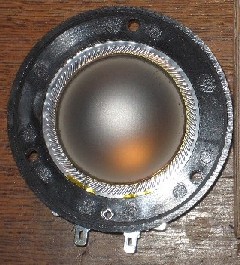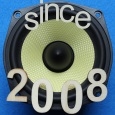- Home
- Questions?
- About diaphragms
About diaphragms
On the internet you will find many vendors that offer replacement diaphragms for your tweeters. Generally there is a distinction between the 'original diaphragm' and the 'aftermarket diaphragms’. Even though the word 'original' might seem seeclear and unambiguous, it is not. Sometimes a manufacturer will buy from another manufacturer and just stick their brand sticker on it. Is this one still original? Anyway, these original diaphragms are of good to very good quality and pretty durable if treated the righ way. They are unfortunately sold at very high prices (through dealers).
Then there are the 'aftermarket diaphragms'. This is a very opaque market. Sometimes these are 'original diaphragms' where the registration/brand sticker is missing, sometimes they are excellent 100% copies of the original and sometimes they are low quality products. Defects that we have discovered in aftermarket diaphragms include:
The use of lower grade (cheaper) materials
The titanium dome is replaced with aluminum, the copper-plated aluminum coil is replaced by an aluminum coil, flat wire (ribbon) coil is replaced by a round wire coil etc. For the avarege customer, these differences are difficult to see, especially on a vague/small picture offered on the web. We have seen many, many diaphragms and have more experience to see the difference.
The sizes are slightly different
By the use of another coil, the coil will be thicker or thinner so that the coil might rub the magnet or the efficiency of the unit decreases. Sometimes the holes in the diaphragm are just not positioned correctly, a problem common in aftermarket JBL diaphragms. As a result, the diaphragms is very difficult to place.
Then there are the 'aftermarket diaphragms'. This is a very opaque market. Sometimes these are 'original diaphragms' where the registration/brand sticker is missing, sometimes they are excellent 100% copies of the original and sometimes they are low quality products. Defects that we have discovered in aftermarket diaphragms include:
The use of lower grade (cheaper) materials
The titanium dome is replaced with aluminum, the copper-plated aluminum coil is replaced by an aluminum coil, flat wire (ribbon) coil is replaced by a round wire coil etc. For the avarege customer, these differences are difficult to see, especially on a vague/small picture offered on the web. We have seen many, many diaphragms and have more experience to see the difference.
The sizes are slightly different
By the use of another coil, the coil will be thicker or thinner so that the coil might rub the magnet or the efficiency of the unit decreases. Sometimes the holes in the diaphragm are just not positioned correctly, a problem common in aftermarket JBL diaphragms. As a result, the diaphragms is very difficult to place.
Poor packaging
Most aftermarket are produced in the Far East (China, Taiwan, Thailand, Japan) and then transprted to Europe or the USA. A small aperture damage makes it unusable al. Only well-packaged diaphragms survive the journey to your front door. In general, the quality of the packaging with the price.
In recent years we have gained much experience with diaphragms and we keep gaining experience visiting speaker producers. After visiting a number of factories in the countries mentioned and testing a large number of samples, we came to our current range. We guarantee that your diaphragm will fit, will work according to the specifications and were manufactured using the materials promised. Our diaphragms are perhaps not the cheapest aftermarket diaphragms that you can find, you might see cheaper ones elsewhere, but we guarantee you this quality for a lower price will be very hard (if not impossible) to find.
For example, an aftermarket diaphragm for Eminence in two qualities:


Although the photos are not of too good quality, there are clear differences we can see.
- The material of the right-hand aperture is most likely aluminum (color) where is should be Ti
- The holes in the edge of the aperture on the right are not entirely pierced and may not be deep enough
- The 'drawing' in the right-hand edge of the aperture is different from the original
- The mounting of the voice coil on the metal dome is stronger on the left one than on the right one
Our advice: orient yourself well gefore you buy your diaphragm.
manuals
Replacing a diaphragm is generally simple, and can, in general, be done without soldering. Below are some links to instructional videos:
- An instructional video for the JBL EON15 and 2418 is available here.
- An instructional video for Electro-Voice DH3, 2010, Eliminator, etc. here.
- An instructional video for Foster / Fostex, Yamaha, etc here.
- An instructional video for Mackie here.
If your diaphragm is not listed above, simply look at a search engine or search on youtube. Replacing diaphragms is a standard procedure, so we recommend you to watch one or two of the above videos so you get the picture.


 Nederlands
Nederlands
 Deutsch
Deutsch